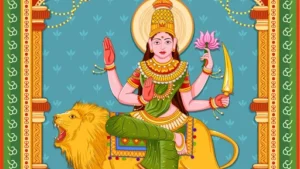UPSC GS 1
Goddess Katyayani
- News: The Prime Minister, Shri Narendra Modi has prayed to Goddess Katyayani on the sixth day of Navratri.
- Definition:
-
- The goddess is known as ‘Mahishasur Mardini’ for defeating the demon king Mahishasura. According to the Vamana Purana, the gods united their powers to form Maa Katyayani in response to the vicious actions of the evil demon Mahishasura.
- She is depicted seated on a lion, with a sword and a lotus in her left hand and making Abhaya and Varada gestures with her right hand.
- She is known as the ‘eliminator of wickedness’ as well.
- She is regarded as the presiding deity of Braj.
-
Read also: Israel-Lebanon War: Causes, and Global Impact | UPSC
Negro River
- News: Water level of Brazil’s Negro River has dropped far below normal levels amid unusually intense dry season.
- Overview:
-
- The Negro River, also known as Rio Negro, is one of the largest tributaries of the Amazon River and holds the distinction of being the largest blackwater river globally.
-
- Geography:
-
- It primarily flows through Colombia, Venezuela, and Brazil.
-
- Source:
-
- The river originates from the highlands of Colombia and Venezuela, beginning as the Guainía River in Colombia.
- It flows eastward, entering Brazil, where it is referred to as the Negro River.
-
- Length:
-
- With a length of approximately 2,250 kilometers (1,400 miles), it is among the longest tributaries of the Amazon River.
-
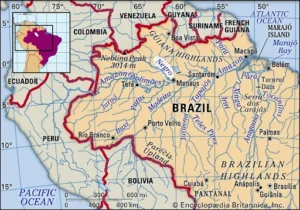
- Unique Water Characteristics:
-
- The dark color of the Negro River’s waters is due to the high concentration of organic matter from decaying vegetation, which releases tannins into the water, giving it a tea-like hue.
-
- Confluence:
-
- The Negro River merges with the Amazon River near the city of Manaus, Brazil. This junction forms the famous “Meeting of Waters,” where the dark Negro River flows alongside the lighter, sandy-colored waters of the Amazon for several kilometers before eventually mixing.
-
- Biodiversity:
-
- The basin of the Negro River supports a wide range of plant and animal life, including species like pink river dolphins, giant otters, and many types of fish, some of which are unique to this ecosystem.
-
- Human Settlements:
-
- Indigenous peoples have inhabited the banks of the Negro River for thousands of years. Today, urban centers like Manaus are major cities located along the river.
-
Pashtuns
- News: The Pakistan government has banned the Pashtun Tahafuz Movement (PTM), a group which fights for the rights of ethnic Pashtuns, citing it as a threat to national security.
- Definition:
-
- The Pashtuns are an ethnic group predominantly found in Afghanistan and Pakistan.
- They primarily inhabit the region between the Hindu Kush in northeastern Afghanistan and the northern stretches of the Indus River in Pakistan.
- The ‘Durand Line’—a boundary established during British colonial rule in the late 19th century—divides the Pashtun population between Afghanistan and Pakistan.
-

- Demographics:
-
- In Afghanistan, Pashtuns make up the largest ethnic group, comprising around 40-50% of the population.
- Historically, they were exclusively referred to as “Afghans” before the term came to represent all residents of Afghanistan.
-
- Language and Religion:
-
- Pashtuns speak Pashto, one of Afghanistan’s official languages.
- Many are also conversant in Farsi (Persian), which is often used for trade and business interactions.
- They follow Sunni Islam and are bound by a common social code known as Pashtunwali, which governs ethical behavior and customs.
-
- Social Structure:
-
- Kinship plays a central role in Pashtun society, with tribes consisting of individuals who trace their male ancestry to a common tribal forefather.
- Each tribe is divided into clans, sub-clans, and patriarchal families.
-
- Occupation:
-
- Most Pashtuns are engaged in farming, often combining crop cultivation with animal husbandry.
- Some are migratory herders and caravan traders.
- Many also serve in the military, while smaller numbers hold political positions.
-
UPSC GS 3
Eco-Sensitive Zones
- News: Namdapha National Park & Tiger Reserve and Kamlang Wildlife Sanctuary & Tiger Reserve in Arunachal Pradesh have been designated as Eco-Sensitive Zones (ESZ) by the MoEFCC, enhancing conservation efforts.
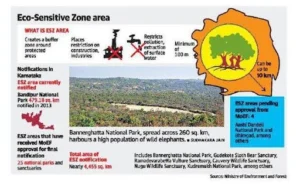
- Eco-Sensitive Zones (ESZ):
-
- As per the National Wildlife Action Plan (2002-2016), formulated by the Union Ministry of Environment, Forest and Climate Change, the land within a 10-km radius of national parks and wildlife sanctuaries is to be designated as Eco-Sensitive Zones (ESZ) or eco-fragile areas.
- While this 10-km guideline is the general rule, the application can differ depending on specific ecological needs.
- The Union government can also extend the notification to areas beyond 10 km if they include ecologically vital “sensitive corridors.”
-
- Role of ESZs:
-
- Eco-Sensitive Zones serve as buffer areas surrounding Protected Areas, such as national parks, wildlife sanctuaries, and tiger reserves.
- They provide a transition zone, ensuring a smoother interface between wildlife habitats and human activities.
-
- Significance of ESZs:
-
- Eco-Sensitive Zones are designed to act as “shock absorbers” for protected areas, reducing harmful impacts on fragile ecosystems caused by human activities in nearby regions.
- These zones offer a gradient of protection, transitioning from areas of stricter conservation to regions with comparatively relaxed protection measures.
-
- Permitted Activities in ESZ:
-
- Ongoing agricultural and horticultural practices
- Rainwater harvesting
- Organic farming
-
- Prohibited Activities in ESZ:
-
- Commercial mining
- Stone quarrying
- Large hydroelectric projects
- Polluting industries
- Brick kilns
-
- Regulated Activities in ESZ:
-
- Establishment of hotels and resorts
- Small-scale non-polluting industries
- Construction of civic amenities
-
- Tiger Reserves:
-
- Namdapha Tiger Reserve, originally designated as a reserve forest, was declared a Wildlife Sanctuary in 1972 under the Assam Forest Regulation.
- It became a National Park in 1983 and later a Tiger Reserve under the Project Tiger Scheme.
- It is home to a range of rare and endangered species, including clouded leopards and red pandas.
- The Kamlang River flows through the Kamlang Wildlife Sanctuary.
- Kamlang Wildlife Sanctuary is crucial for the protection of species like the Hoolock gibbon and hornbills, making it a key site for biodiversity conservation in the region.
-
World Cotton Day
- News: The Ministry of Textiles jointly hosted the conference with Confederation of Indian Textile Industries (CITI) and Cotton Corporation of India on World Cotton Day.
- World Cotton Day: October 7 is celebrated globally as World Cotton Day.
- Theme 2024: “Megatrends Shaping Cotton Textile Value Chain”.
- Cotton:
-
- Cotton is one of the most important cash crops and accounts for around 21% of the total global fibre production.
- In the raw material consumption basket of the Indian textile industry, the proportion of cotton is around 60%.
- Due to its economic importance in India, it is also termed as “White-Gold”.
-
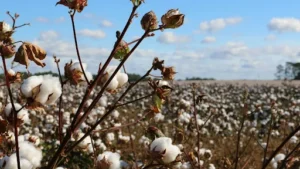
- Cotton Producing Countries:
-
- The largest cotton producing countries are China and India, followed by the United States of America and Brazil.
- The textiles and apparel industry in India is the 2nd largest employer in the country providing direct employment to 45 Mn people.
- To support the cotton industry, Government of India announces Minimum Support Price (MSP) for two basic staples groups viz., medium staple and long staple cotto.
- Cotton Corporation of India (CCI), a Public Sector Undertaking under the Ministry of Textiles, is the nodal agency of Government of India for undertaking MSP operations in the event of prevailing seed cotton (kapas) price touching the MSP level.
-
Air Force Day
- News: Prime Minister Modi has conveyed his greetings to India’s brave air warriors on occasion of Air Force Day (8th October).
- Air Force Day: It marks the establishment of IAF in 1932 as part of British Indian Military.
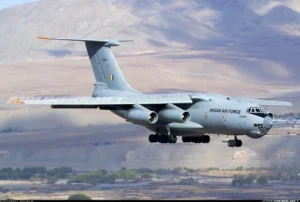
- Indian Air Force:
-
- It is the fourth largest Air Force in the world.
- Arjan Singh DFC was the first ever ‘Marshal of the Air Force’.
-
Halari Donkey
- News: The endangered Halari donkeys, native to the Halar region of Gujarat, are considered to be intelligent animals which work closely with human beings.
- About:
-
- Native to the Saurashtra region of Gujarat, India.
- A rare and distinctive breed known for its unique physical features and historical importance.
- Halari donkey milk is among the most expensive in the world, fetching prices up to Rs 1000 due to its medicinal benefits.
-
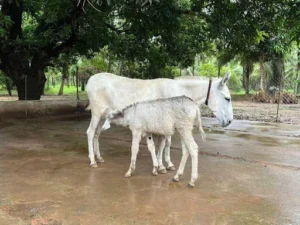
- Characteristics:
-
- Appearance: Typically white or light gray with a strong, muscular build, and a small to medium size.
- Adaptability: Well-suited to arid and semi-arid climates, exhibiting high endurance, which allows them to thrive in harsh conditions.
- Diet: Capable of surviving on minimal food and water, making them ideal for resource-scarce environments.
-
- Uses:
-
- Agricultural Work: Traditionally used for transportation and agricultural purposes, such as carrying loads and assisting farmers.
- Medicinal Value: Their milk is believed to have medicinal properties, with a growing demand due to its health benefits, including boosting immunity and treating respiratory issues.
-
- Conservation Status:
-
- The population of Halari donkeys is declining, driven by mechanization, reduced reliance on animal labor, and limited awareness of their value.
- They are currently in a vulnerable state, requiring urgent conservation efforts to halt their population decline.
- Conservationists stress the need to protect their genetic diversity and preserve the cultural heritage linked to this traditional breed.
-
- IUCN Status: Endangered
Read also: University Ranking Framework: A Comprehensive Guide | UPSC
Airborne Early Warning and Control (AEW&C) Aircraft
- News: The Indian Air Force (IAF), which is short of Airborne Early Warning and Control (AEW&C) aircraft, a critical force multiplier, is looking at the procurement of 12 aircraft under two different programmes.
- Purpose: This procurement aims to mitigate the shortfall in AEW&C aircraft, a need emphasized during the 2019 aerial engagement with the Pakistan Air Force after the Balakot airstrike.

- Existing AEW&C and AWACS Systems:
-
- The IAF currently operates three Phalcon AWACS mounted on IL-76 aircraft, offering 360-degree coverage.
- Additionally, the IAF uses three Netra AEW&C systems, which provide 240-degree coverage.
-
- First Program: Embraer-Based AEW&C Mk1A:
-
- The IAF presently operates three Netra AEW&C systems, based on Embraer aircraft.
- Plans are underway to acquire six additional AEW&C systems, designated as Mk1A, which will feature minor equipment upgrades.
- Embraer will supply the aircraft, while DRDO’s Centre for Airborne Systems (CABS) will handle the modifications. The Defence Acquisition Council is expected to approve this proposal soon.
-
- Second Program: Airbus-Based AEW&C Mk2:
-
- The IAF is also procuring six AEW&C systems to be installed on Airbus A-321 aircraft.
- Airbus will undertake the aircraft modifications, while DRDO will develop the onboard equipment.
- Contract discussions with Airbus are ongoing, focusing on finalizing configurations and pricing. Six passenger aircraft from Air India have been transferred to the IAF for modification.
-

